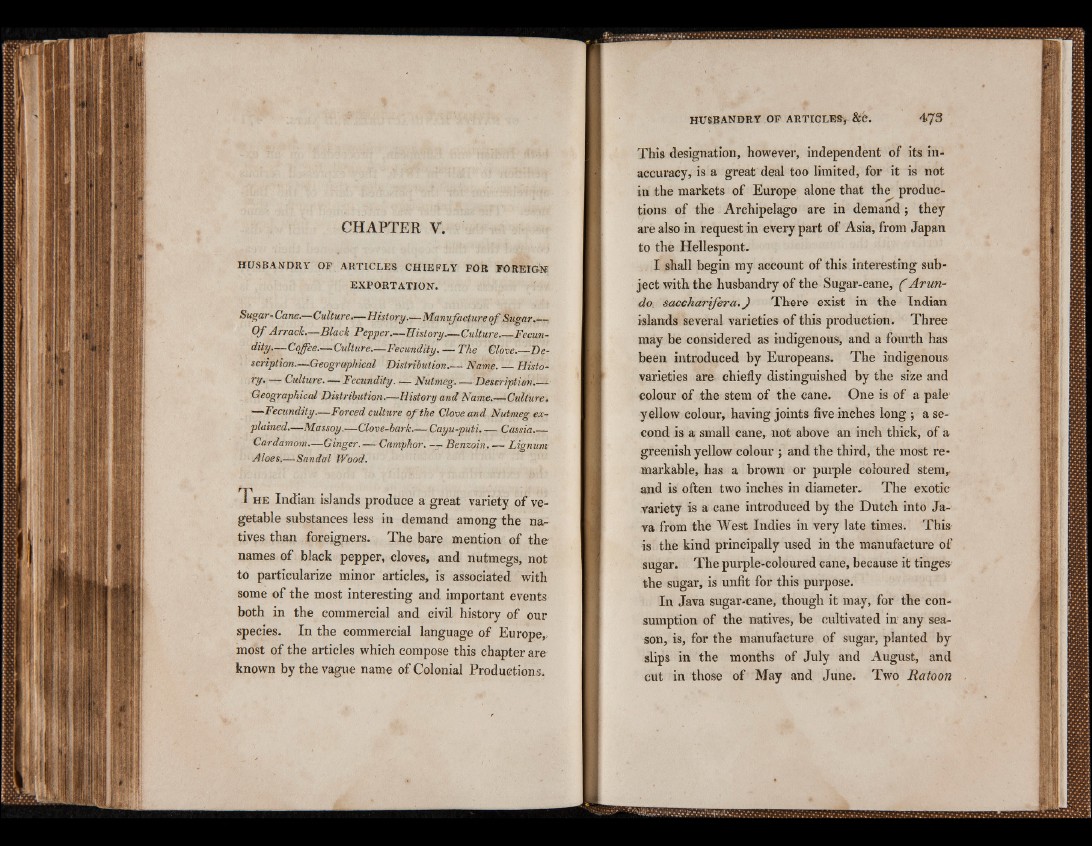
CHAPTER V.
HUSBANDRY OF ARTICLES CHIEFLY FOR FOREIGN
EXPORTATION»
Sugar- Cane.—Culture.—History.— Manufacture o f Sugar.—
O f Arrack.—Black Pepper.—History.— Culture.—Fecundity.—
Coffee— Culture— Fecundity. — The Clove— Description—
Geographical Distribution.— Ñame. — Histo-
Ty* — Culture. — Fecundity. — Ñutmeg. — Description.—
Geographical Distribution.— History and Name Culture.
—Fecundity.— Forced culture o f the Clove and Nutmeg explained.—
Massoy.—Clove-bark.— Cayu-puti. — Cassia.—
Cardamom.-—Ginger. — Camphor. —— Benzoin. — Lignum
Aloes.— Sandal Wood.
r ri 1 h e Indian islands produce a great variety of vegetable
substances less in demand among the natives
than foreigners. The bare mention of the
names of black pepper, cloves, and nutmegs, not
to particularize minor articles, is associated with
some of the most interesting and important events
both in the commercial and civil history of our
species. In the commercial language of Europe,
most of the articles which compose this chapter are
known by the vague name of Colonial Production s»
This designation, however, independent of its inaccuracy,
is a great deal too limited, for it is not
in the markets of Europe alone that the^ productions
of the Archipelago are in demand; they
are also in request in every part of Asia, from Japan
to the Hellespont.
I shall begin my account of this interesting subject
with the husbandry of the Sugar-cane, { Arun-
do saccharifera.J There exist in the Indian
islands several varieties of this production. Three
may be considered as indigenous, and a fourth has
been introduced by Europeans. The indigenous
varieties are chiefly distinguished by the size and
colour of the stem of the cane. One is of a pale
yellow colour, having joints five inches long $ a second
is a small cane, not above an inch thick, of a
greenish yellow colour j and the third, the most remarkable,
has a brown or purple coloured stem*
and is often two inches in diameter. The exotic
variety is a cane introduced by the Dutch into Java
from the West Indies in very late times. This
is the kind principally used in the manufacture of
sugar. The purple-coloured cane, because it tinges
the sugar, is unfit for this purpose.
In Java sugar-cane, though it may, for the consumption
of the natives, be cultivated in any season,
is, for the manufacture of sugar, planted by
slips in the months of July and August, and
cut in those of May and June. Two Ratoon